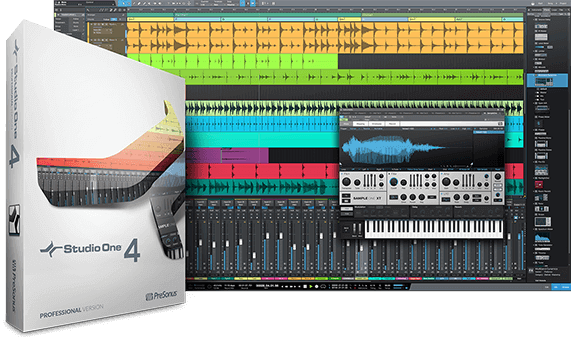Back in August 2015, we reviewed PreSonus’s Studio One 3. Since that time our review team has used it as a go-to platform for some of our other review items, from studio mics and preamps to DAW plug-ins, with no issues. Now, PreSonus has rolled out Studio One 4, and we’ve made the upgrade, and explored its new features. While they have a plethora of new goodies under the hood, we wanted to go over some of the ones that really stand out.
The big thing with a lot of today’s artists is sharing work, but getting different studios and collaborators to use the same DAW software is at times impossible. With AAF importing, a session created in another DAW can be ported into SO4 easily; all of the tracks come in like they did from their original, and now they can live in the world of SO4. Want to re-mix that song that was done in Logic or Pro Tools? Look no further. Have a friend or bandmate who hasn’t seen the light and is still using some other prehistoric software? Well Studio One sessions can be exported for their use as well.
Getting things set up in a new session can be tiring, and takes up time when you just want to get to work. With the Import Song Data function, the user can now open a new session and select the specific session info from a different session. So, no need to create the same channels over again – it will give you the same track listing, tempos, etc. It can also bring in the virtual instrumentation, inserts, and track layers and automations. So, if you’re doing a session with three songs, once one song is all structured, trackwise, setting the other two up for the next one can be done in seconds. During a mix, wanting to bring in the same events, it’s well worth it in the saved setup time.
The chord tracking, or harmonic editing is really exciting for songwriters. It detects the audio (or MIDI) and will outline the chords being played. Want to change that Dmajor to a Gmajor? No problem. It will re-harmonize the track to that chord. This is great for songwriters who might want to quickly transpose their music and give chord charts to other musicians.
Another great songwriting tool is ripple editing, which allows the user to actually re-arrange the overall track. Remember how easy you thought it was to cut and paste arrangements, and then realized it’s not that easy, with so much going into making everything sound natural? SO4 made it actually THAT easy. Kudos.
Doing MIDI drums in a DAW is old hat, but SO4 changed the interface a bit, going from a keyboard to a list of the actual drum bits. There’s no having to think of Middle C as a Snare, and B as the kick drum. Placement is just as easy and knowing where to put the desired beats on that particular drum makes it even easier. Among these lines, is their new pattern editing feature; it works like a step sequencer, and allows the user to input note patterns individually, but apply individual note velocity and effects to each note as well. It changes a traditional piano or synth part from a canned bit to a very expressive way to tailor the patterns to your musical desires.
We found the MIDI editor in Studio One much easier to use than other software packages we’ve tested in the past, and the crazy amount of great-sounding virtual instruments at your disposal in the side-panel selector are a blessing for any producer who just wants to sit down with a controller and start piecing a song together without a lot of hassle or menu-diving. In seconds, we had a multi-track session going with killer drum patterns, analog audio from our office Moog, and a Les Paul-style guitar soft synth lead layered on top. All seamless, all easy, nothing in the way. As it should be!
There’s also a notepad feature included where in the console view, so specific notes can be typed in. This is a great tool for reference, especially when mixing. During a long session where ear fatigue may make you chase audio ghosts, make a note such as “snare too tinny?” Come back to it later on and re-listen. That note might make sense to either address the issue, or dismiss it. At the least it can provide some extra documentation in the actual session itself, and not on a post-it stuck to a monitor, or some notebook that’ll get forgotten or lost.
A small but notable adjustment now available is the ability to change the overall appearance of the interface, lightening things up where it can look a bit more like another popular recording software interface. Working on a laptop remotely, this feature can come in handy to help prevent eye fatigue, and makes low-light or harsh light situations easy to adjust for.
Overall, it’s got a lot going on, and these features we’re outlining are the just some of our personal highlights. Any studio owner, producer, engineer, DIY recording situation could benefit from at least one of these from the standpoint of new creativity, as well as just workflow and productivity.
